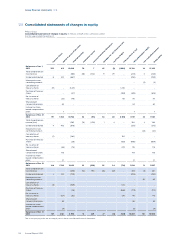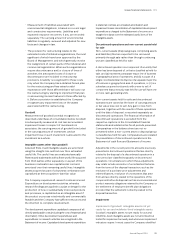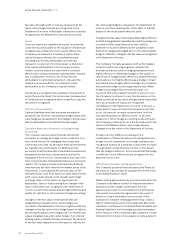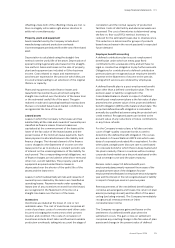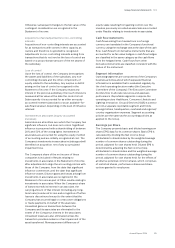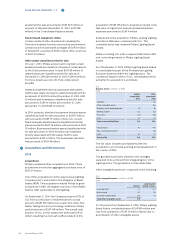Philips 2014 Annual Report Download - page 120
Download and view the complete annual report
Please find page 120 of the 2014 Philips annual report below. You can navigate through the pages in the report by either clicking on the pages listed below, or by using the keyword search tool below to find specific information within the annual report.Group nancial statements 12.9
120 Annual Report 2014
its cash generating units as one level below that of an
operating segment. Cash ows at this level are
substantially independent from other cash ows and this
is the lowest level at which goodwill is monitored by the
Executive Committee. The Company performed and
completed annual impairment tests in the same quarter of
all years presented in the Statements of income. An
impairment loss is recognized in the Statement of income
whenever and to the extent that the carrying amount of a
cash-generating unit exceeds the unit’s recoverable
amount, which is the greater of its value in use and fair
value less cost to sell. Value in use is measured as the
present value of future cash ows expected to be
generated by the asset.
Impairment of non-nancial assets other than
goodwill, intangible assets not yet ready for use,
indenite-lived intangible assets, inventories and
deferred tax assets
Non-nancial assets other than goodwill, intangible
assets not yet ready for use, indenite-lived intangible
assets, inventories and deferred tax assets are reviewed
for impairment whenever events or changes in
circumstances indicate that the carrying amount of an
asset may not be recoverable. Recoverability of assets
to be held and used is recognized and measured by a
comparison of the carrying amount of an asset with the
greater of its value in use and fair value less cost to sell.
Value in use is measured as the present value of future
cash ows expected to be generated by the asset. If the
carrying amount of an asset is deemed not recoverable,
an impairment charge is recognized in the amount by
which the carrying amount of the asset exceeds the
recoverable amount. The review for impairment is
carried out at the level where cash ows occur that are
independent of other cash ows.
Impairment losses recognized in prior periods are
assessed at each reporting date for any indications that
the loss has decreased or no longer exists. An
impairment loss is reversed if and to the extent there
has been a change in the estimates used to determine
the recoverable amount. The loss is reversed only to the
extent that the asset’s carrying amount does not exceed
the carrying amount that would have been determined,
net of depreciation or amortization, if no impairment
loss had been recognized. Reversals of impairment are
recognized in the Statement of income.
Impairment of nancial assets
A nancial asset is considered to be impaired if
objective evidence indicates that one or more events
have had a negative eect on the estimated future cash
ows of that asset. In case of available-for-sale
nancial assets, a signicant or prolonged decline in the
fair value of the nancial assets below its cost is
considered an indicator that the nancial assets are
impaired. If any such evidence exists for available-for-
sale nancial assets, the cumulative loss - measured as
the dierence between the acquisition cost and the
current fair value, less any impairment loss on that
nancial asset previously recognized in the Statement
of income - is reclassied from the fair value reserve in
equity (through Other comprehensive income) to the
Statement of income.
If objective evidence indicates that nancial assets that
are carried at cost need to be tested for impairment,
calculations are based on information derived from
business plans and other information available for
estimating their fair value. Any impairment loss is
charged to the Statement of income.
An impairment loss related to nancial assets is
reversed if in a subsequent period, the fair value
increases and the increase can be related objectively to
an event occurring after the impairment loss was
recognized. The loss is reversed only to the extent that
the asset’s carrying amount does not exceed the
carrying amount that would have been determined if no
impairment loss had been recognized. Reversals of
impairment are recognized in the Statement of income
except for reversals of impairment of available-for-sale
equity securities, which are recognized in Other
comprehensive income.
Other policies
Foreign currencies
Foreign currency transactions
The financial statements of all group entities are measured
using the currency of the primary economic environment in
which the entity operates (functional currency). The euro
(EUR) is the functional and presentation currency of the
Company. Foreign currency transactions are translated into
the functional currency using the exchange rates prevailing
at the dates of the transactions or valuation where items are
remeasured. Foreign exchange gains and losses resulting
from the settlement of such transactions and from the
translation at year-end exchange rates of monetary assets
and liabilities denominated in foreign currencies are
recognized in the Statement of income, except when
deferred in Other comprehensive income as qualifying cash
flow hedges and qualifying net investment hedges.
Foreign currency dierences arising from translation
are recognized in the Statement of income, except for
available-for-sale equity investments which are
recognized in Other comprehensive income, except on
impairment in which case foreign currency dierences
that have been recognized in Other comprehensive
income are reclassied to the Statement of income.
All exchange difference items are presented as part of Cost
of sales, with the exception of tax items and financial income
and expense, which are recognized in the same line item as
they relate in the Statement of income.
Non-monetary assets and liabilities denominated in
foreign currencies that are measured at fair value are
retranslated to the functional currency using the exchange
rate at the date the fair value was determined. Non-






